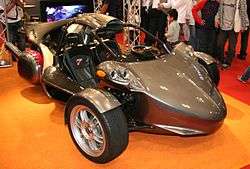Three-wheeler
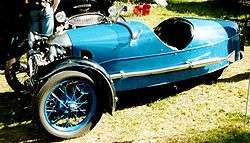



A three-wheeler is a vehicle with three wheels. Some are motorized tricycles, which may be legally classed as either automobiles or motorcycles, while others are tricycles without a motor, some of which are human powered vehicles and animal powered vehicles.
Overview
Many three-wheelers which exist in the form of motorcycle-based machines are often called trikes and often have the front single wheel and mechanics similar to that of a motorcycle and the rear axle similar to that of a car. Often such vehicles are owner-constructed using a portion of a rear-engine, rear-drive Volkswagen Beetle in combination with a motorcycle front end. Other trikes include ATVs that are specially constructed for off road use.
Three-wheeled automobiles can have either one wheel at the back and two at the front, (for example: Morgan Motor Company) or one wheel at the front and two at the back (such as the Reliant Robin). Due to better safety when braking, an increasingly popular form is the front-steering "tadpole" or "reverse trike" sometimes with front drive but usually with rear drive. A variant on the 'one at the front' layout was the Scott Sociable, which resembled a four-wheeler with a front wheel missing.[1]
Three-wheeler cars, including some cyclecars, bubble cars and microcars, are built for economic reasons: in the UK for tax advantages, or in the US to take advantage of lower safety regulations, being classed as motorcycles. As a result of their light construction and potential better streamlining, three-wheeled cars are usually less expensive to operate.
Three-wheeler transport vehicles known as auto rickshaws are a common means of public transportation in many countries in the world, and are an essential form of urban transport in many developing countries such as India and the Philippines.
Auto rickshaws are a form of novelty transport in many Eastern countries.
History
Early automotive pioneer Karl Benz developed a number of three-wheeled models.[2] One of these, the Benz Patent Motorwagen,[3] is regarded as the first purpose-built automobile. It was made in 1885.
In 1896, John Henry Knight showed a tri-car at The Great Exhibition.[2]
In 1897, Edward Butler (inventor) made the Butler Petrol Cycle, another three-wheeled car.
A Conti 6 hp Tri-car competed in (but did not complete) a 1907 Peking-to-Paris race sponsored by a French newspaper, Le Matin.[4]
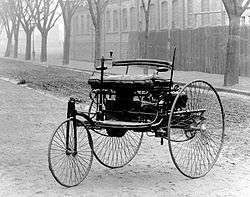 1885 Benz Patent Motorwagen.
1885 Benz Patent Motorwagen. Goliath Tempo pickup truck at a meeting for vintage cars in the Nineties
Goliath Tempo pickup truck at a meeting for vintage cars in the Nineties
 Davis 494, at the National Automotive and Truck Museum, Auburn, Indiana, US
Davis 494, at the National Automotive and Truck Museum, Auburn, Indiana, US_Auto.jpg) Folding City Car: Zaschka Three-wheeled car, 1929. Engelbert Zaschka, German inventor, and his folding three-wheeler
Folding City Car: Zaschka Three-wheeled car, 1929. Engelbert Zaschka, German inventor, and his folding three-wheeler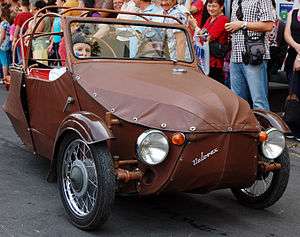 Velorex was a manufacturing cooperative in Solnice, Czechoslovakia, formed in 1936 to satisfy demand for small, inexpensive city cars
Velorex was a manufacturing cooperative in Solnice, Czechoslovakia, formed in 1936 to satisfy demand for small, inexpensive city cars
Configurations
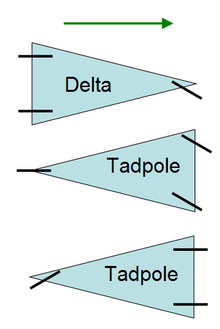
Two front
A configuration of two wheels in the front and one wheel at the back presents two advantages: it has improved aerodynamics, and that it readily enables small lightweight motorcycle powerplant and rear wheel to be used. This approach was used by the Messerschmitt KR200 and BMW Isetta. Alternatively, a more conventional front-engine, front wheel drive layout as is common in four-wheeled cars can be used, with subsequent advantages for transversal stability (the center of gravity is further to the front) and traction (two driven wheels instead of one).
With two wheels in the front (the "tadpole" form or "reverse trike") the vehicle is far more stable in braking turns, but remains more prone to overturning in normal turns compared to an equivalent four-wheeled vehicle, unless the center of mass is lower and/or further forward. Motorcycle-derived designs suffer from most of the weight being towards the rear of the vehicle.
For lower wind resistance (which increases fuel efficiency), a teardrop shape is often used. A teardrop is wide and round at the front, tapering at the back. The three-wheel configuration allows the two front wheels to create the wide round surface of the vehicle. The single rear wheel allows the vehicle to taper at the back. Examples include the Aptera 2 Series and Myers Motors NmG.
Two rear
Having one wheel in front and two in the rear for power reduces the cost of the steering mechanism, but greatly decreases lateral stability when cornering while braking.
When the single wheel is in the front (the "delta" form, as in a child's pedal tricycle), the vehicle is inherently unstable in a braking turn, as the combined tipping forces at the center of gravity from turning and braking can rapidly extend beyond the triangle formed by the contact patches of the wheels. This type, if not tipped, also has a greater tendency to spin out ("swap ends") when handled roughly.
Lateral stability
The disadvantage of a three-wheel configuration is lateral instability - the car will tip over in a turn before it will slide. This can be prevented in 3 different ways:
- by placing the centre of mass closer to the ground
- by placing the centre of mass closer to the rear wheels
- by increasing the track width
In the case of a three wheeled ATV, tipping can be avoided by the rider leaning into turns.
Tilting option

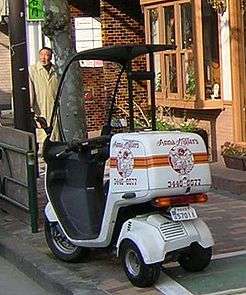
To improve stability some three-wheelers are designed as tilting three-wheelers so that they lean while cornering like a motorcyclist would do. The tilt may be controlled manually, mechanically or by computer.
A tilting three-wheeler's body and or wheels tilt in the direction of the turn. Such vehicles can corner safely even with a narrow track.
Some tilting three-wheelers could be considered to be forms of feet forwards motorcycles, or cabin motorcycles, or both.
Wheel configurations
Several configurations are practical. Two front wheels and one rear, where all three wheels tilt, use the acronym 2F3T (i.e. two front three tilt). Other variations 1F1T, where only the front wheel tilts, an example being the Vandenbrink Carver, made in the Netherlands.
Active or passive tilt control
Tilting can be actively controlled by applying force between the paired wheels. A "free leaner" is balanced by steering, like a single track vehicle. This still leaves some advantages in traction, and the tilt can be locked for parking faster than a stand can be deployed.
Topology
Propulsion may be on one, two, or three wheels, tilted or not. Many possible arrangements require particularly flexible U-joints, which favours the other possibilities.
Use of 'extra' wheel
Any extra laterally spaced wheel can benefit the vehicle by providing stability gains if there is a mechanism to lock the laterally spaced wheels at any given moment relative to the road plane. In some countersteered vehicles this benefit is generally only available when stopped.
In other types where the tilt angle is directly controlled this additional stability is constant at all speeds.
In a countersteered vehicle a loss of traction will result in a fall whereas in a tilt controlled design a fall may not occur.
Various electric and hydraulic systems have been employed to modify TTW behaviour, with notable success on the Carver.
Due to the tilting, there is not necessarily any load transfer between the wheels in cornering, so the rule about tadpoles (2F or "reverse trike") understeering and Deltas (1F or standard trike) oversteering does not necessarily apply.
Electric
Battery
Three-wheeled battery powered designs include:
- Aptera 2 Series
- Arcimoto
- CityEl
- Commuter Cars Tango
- Cree SAM
- Myers Motors NmG (formerly Corbin Sparrow)
- Toyota i-Road
- Triac
- ZAP Xebra
Solar

The world's fastest solar-powered vehicle, Ashiya University's Sky Ace TIGA, is a three-wheeler. It achieved 91.332 kilometres per hour (56.751 mph) at Shimojishima Airport, in Miyakojima, Okinawa, Japan, to win the Guinness World Record, on 20 August 2014.[5] It took the record from another three-wheeler, Sunswift IV, designed and built at the University of New South Wales in Australia,[6] by a margin of almost 3 km/h.
Steam
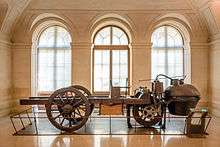
The world's first full-size self-propelled land vehicle was a three-wheeler. French Army Captain Nicolas-Joseph Cugnot's 1770 fardier à vapeur (steam dray), a steam tricycle with a top speed of around 3 km/h (2 mph), was intended for hauling artillery.[7]
Another of the earliest preserved examples is the Long steam tricycle, built by George A. Long around 1880 and patented in 1883,[8][9] now on display at the Smithsonian Institution.
All-terrain vehicles

Due to the incidence of injuries related to their use, a 10-year ban, entirely voluntary for manufacturers, was placed on the sale of new three-wheeled all-terrain vehicles in the United States in January 1988. However, it should be noted that more injuries were sustained by riders by not applying a proper riding technique, and lack of wearing proper safety gear such as helmets and riding boots. In a search conducted by the Consumer Product Safety Commission, it was determined that "no inherent flaw was found in the three wheel design".
Registration
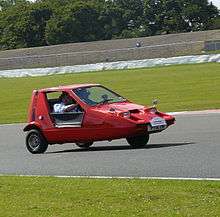
In the U.S, the National Highway Traffic Safety Administration defines and regulates three-wheeled vehicles as motorcycles.[10]
Driver's license requirements vary on a state-by-state basis. In other jurisdictions, such as British Columbia, Canada, and Connecticut, a three-wheeled vehicle with an enclosed passenger compartment or partially enclosed seat is considered an automobile.
Examples
Two front wheels
| Name | Country | Years manufactured | Comments |
|---|---|---|---|
| Léon Bollée Voiturette | France | 1895-? | |
| Berkeley Cars Berkeley T60 | England | 1959 | |
| Egg | Switzerland | 1896-99 | |
| Advance 6 hp air-cooled Tri Car and 9 hp water-cooled Tri Car[11] | England | 1902-12 | |
| Humber Tricar[12][13] | England | 1904 | |
| Riley Olympia Tricar[14] | England | 1904 | [15] |
| Lagonda Tricar[16] | England | 1904-07 | total production: 69 cars |
| Anglian | England | 1905-07 | |
| Armadale | England | 1906-07 | |
| Morgan V-Twin and F-Series | England | 1911-39, 1932–52 | Morgan Super Sports 2-Seater 1937 |
| American Tri-Car | United States | 1912 | |
| Birmingham Small Arms Company Three Wheeler | England | 1929-36 | 1100cc engine[17] |
| Zaschka | Germany | 1929 | Folding three-wheeler: Zaschka Three-wheeler 1929 |
| Dymaxion car | United States | 1933 | Concept car designed by Buckminster Fuller |
| Mathis VEL 333 | France | 1946 | 3 seats, flat-twin front engine, aluminium body, production less than 10 units |
| 1951 Hoffmann | Germany | 1951 | 2 seats, aluminium body, engine mounted on the rear wheel steering pivot |
| Velorex Oskar and other models | Czechoslovakia | 1951-71 | Originally with leather bodies |
| Isetta | UK | 1957-62 | Three-wheeled version of the Isetta built in the UK to take advantage of tax and licensing regulations |
| Scootacar | UK | 1957-64 | |
| Messerschmitt KR175 | Germany | 1953-55 | |
| Messerschmitt KR200 | Germany | 1955-64 | |
| Peel P50 | Isle of Man | 1963-64 | Smallest production car ever built |
| HM Vehicles Free-way | United States | 1979-82 | |
| Campagna T-Rex | Canada | 1996–present | |
| Malone Car Company F1000|Skunk SS|TAZR | United Kingdom | 1999–present | High power internal combustion and pure electric versions released November 2010 |
| Cree SAM | Switzerland | 2001 | Electric, only 80 produced |
| Myers Motors NmG ("No more Gas") | United States | 2006–present | Single occupant all-electric plug-in |
| BRP Can-Am Spyder RoadsterCan-Am Spyder Roadster | Canada | 2007–present | The Can-Am Spyder is a three-wheeled motorcycle manufactured by Bombardier Recreational Products |
| Brudeli 645L | Norway | 2008- | |
| Moonbeam | United States | 2008–present | 100 mpg DIY, fabric-covered car based on parts from two Honda 150cc motorscooters[18] |
| Triac | United States | 2009-2011 | Electric, never entered production |
| XR-3 Hybrid | United States | Plans-2008, Kit-2009 | Front 3 cylinder diesel (125 mpg), rear electric 40 mile range -(220 mpg when used as a hybrid)[19] |
| Aptera 2e | United States | Electric or Plug-in hybrid, 300 mpg-US (0.78 L/100 km) | |
| Triton Trikes | United States | 2000–present | Gas power 42+ mpg - Parts lists, customize, Kits Available - call for info |
| Polaris Slingshot | United States | 2015-present | |
| Vanderhall Laguna Roadster | United States | 2016–present | Exotic Auto-cycle, mono-aluminum chassis, carbon fiber body, 200 HP, 1550 pounds dry weight, side-by-side seating, fwd. 1.4 liter turbo GM power plant. 6 speed Automatic with paddle shift option. Manufactured by Vanderhall Motor Works in Provo, Utah U.S.A |
| Elio Motors | Shreveport, LA, United States | Begins 1H 2016[20] | Two passenger fully enclosed cockpit with car controls |
| Girfalco Azkarra | Canada | 2017 | All-electric two-passenger three-wheeled vehicle, possibly the quickest three-wheeler |
| Go3Wheeler | United States | 2014 | single person three wheeler |
| Corbin Sparrow | |||
| Piaggio MP3 | |||
| Tri-Magnum | |||
| Volkswagen GX3 |
Two rear wheels
| Name | Country | Years manufactured | Comments |
|---|---|---|---|
| Apino | Brazil | unknown | Mini Truck |
| Benz Patent Motorwagen | Germany | 1886-93 | |
| Eco-Fueler | USA | 2009–Present | |
| La Va Bon Train | France | 1904-10 | 50-100 believed built |
| Davis D-2 Divan | United States | 1947-48 | about 13-17 built, including the 494, a Jeep-like military vehicle[21] |
| Scammell Scarab | England | 1948-67 | |
| Autoette | United States | 1948-70 | |
| Daihatsu Bee | Japan | 1951-1952 | |
| Daihatsu Midget | Japan | 1957-72 | |
| Mazda T-2000 | Japan | 1957-74 | |
| Mazda K360 | Japan | 1959-69 | |
| Mazda T600 | Japan | 1959-71 | |
| Kia K-360 | Republic of Korea | 1962-1973 | Kia's first truck |
| Kia T-1500 | Republic of Korea | 1963-? | 1484 cc, 60 hp, four cylinder and a maximum load of 1.5 tons. |
| Kia T-600 | Republic of Korea | 1969-1974 | 577cc, 20 HP and 500 kg load. Top speed of 75 km/h. 7726 produced |
| Kia T-2000 | Republic of Korea | 1967-1981 | 1985 cc, 81 hp, four cylinder and a maximum load of 2 tons. 15952 produced |
| Electra-King | United States | 1964?-1980s? | Two-seater electric car[22] |
| Bond 875 | England | 1965-70 | |
| Bond Bug | England | 1970-74 | |
| Reliant Robin | England | 1973-81, 1989-2002 | |
| Reliant Regal | England | 1953–1973 | An example of this vehicle is the iconic van belonging to Del Boy and Rodney Trotter in the long-running BBC sitcom Only Fools and Horses, though it is often incorrectly referred to as a Reliant Robin. |
| GM Lean Machine[23][24] | United States | 1980s | Tilt, concept car[25] |
| Trivette | United States | 1974-1976 | |
| Twike | Germany | 1995–present | Human-electric hybrid |
| ZAP Xebra | United States | 2006-2009 | electric power |
| eTuk | United States | 2014- | re-designed tuk tuk for the US Market, including an all-electric motor[26] |
| Snyder ST600-C | United States | 20??-20?? | |
| Carver | Netherlands | 2007-2009 | Tilt |
| CityEl | |||
| CLEVER | |||
| Harley-Davidson Servi-Car |
References
- ↑ "Scott Sociable". Retrieved 2015-10-05.
- 1 2 Elvis Payne (2012). "The History of the 3-Wheeled Vehicle". 3-wheelers.com. Retrieved 2012-01-03.
- ↑ Chris Chong (July 2, 2006). "History in its magnificence". star-motoring.com. Archived from the original on 2007-10-24. Retrieved 2008-01-20.
- ↑ "History". pekingparisraid.co.uk. Archived from the original on 2007-08-26. Retrieved 2008-01-20.
- ↑ Guinness World Records - Fastest solar-powered vehicle
- ↑ "Aussie car breaks a world speed record". AAP. 7 January 2011. Retrieved 2011-01-07.
- ↑ Fardier de Cugnot
- ↑ "1880 Long Steam Tricycle - Pictures". Remarkablecars.com. 2009-06-17. Retrieved 2010-07-29.
- ↑ "America on the Move | Long steam tricycle". Americanhistory.si.edu. 2008-10-24. Retrieved 2014-06-17.
- ↑ "Highway Safety - Title 23, United States Code, Chapter 4 and Related Highway Safety Provisions" (PDF). December 2008. Retrieved 2015-10-05.
- ↑ "Advance Fore-Cars and Tri-Cars". oakingtonplane.co.uk. Archived from the original on 2008-01-12. Retrieved 2008-01-23.
- ↑ "British Motor Manufacturers (1894-1960) Humber". britishmm.co.uk. Archived from the original on February 21, 2009. Retrieved 2008-01-20.
- ↑ "Humber History". histomobile.com. Archived from the original on June 8, 2007. Retrieved 2008-01-20.
- ↑ "Rileys 1896 - 1939 The Pre-Nuffield Years.". Rob's Riley Pages (ukonline.co.uk/rileyrob). Archived from the original on March 21, 2005. Retrieved 2008-01-20.
- ↑ illustration Archived December 29, 2010, at the Wayback Machine.
- ↑ "The History of Classic Cars: 1905 Lagonda Tricar". autoclassic.com. Retrieved 2008-01-20.
- ↑ Peter Bowler, president The BSAFWD Club. "image and description". Bsafwdc.co.uk. Retrieved 2012-04-09.
- ↑ Wilson, Mark (2006-09-24). "Moonbeam: 100mpg Homemade Car". Gizmodo.com. Retrieved 2015-10-05.
- ↑ "XR3 Hybrid Personal Transit Vehicle: A 125 mpg Plug-In Hybrid Three Wheeler You Build From Plans". Rqriley.com. Retrieved 2012-04-09.
- ↑ "Elio Motors announces delay, production expected to start in 2016". KSLA News 12. Shreveport, LA. 2015-01-15. Retrieved 2015-03-11.
- ↑ Phil Patton, "A Dreamer's Machine, More Promise Than Reality", New York Times (September 24, 2009)
- ↑ Rob & Sharon McLellan. "advertising brochure". Mclellansautomotive.com. Retrieved 2012-04-09.
- ↑ "General Motors Three Wheeled Cars.". GM's Lean Machine (3-wheelers.com/gmlean). Retrieved 2008-04-08.
- ↑ "Lean Machines: Preliminary Investigation" (PDF). Institute of Transportation Studies, University of California at Berkeley (commutercars.com/downloads/studies/). Retrieved 2008-04-08.
- ↑ "illustration". Retrieved 2012-04-09.
- ↑ "eTuk USA". Retrieved 2014-07-01.
